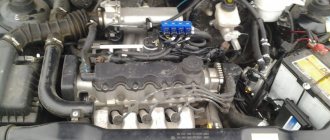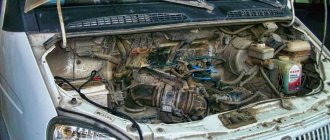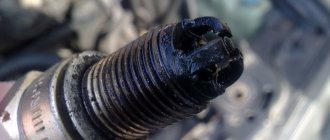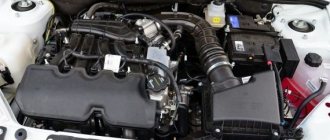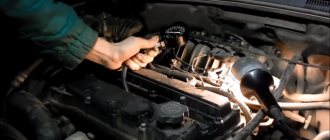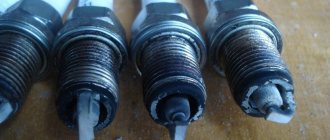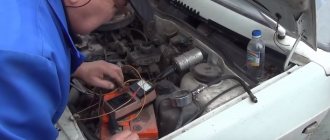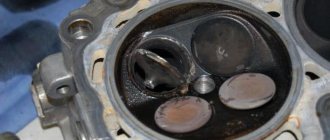Almost every car enthusiast sooner or later encounters such a fairly common malfunction of the internal combustion engine, when the engine stalls. As a rule, in certain situations the engine stalls when hot or only when cold, and tripping can also occur constantly (regardless of the temperature of the power unit, operating mode, load level, etc.).
In short, engine tripping means that one or more cylinders are not firing, and there can be several reasons for such a malfunction. In this article we will talk about why the engine stalls after warming up, how the malfunction can be diagnosed, and what signs help to accurately identify the problem.
Read in this article
The engine stalls when hot: causes and common faults
Let's start with the main features. Often, a cold engine starts quite normally, but then begins to stall after partial warming up or completely reaching operating temperatures. In this case, tripping can occur both at idle and under load (while driving).
- You should start by checking the control system (ECM) and the engine power system. It is recommended to immediately carry out computer diagnostics and check the condition of the injector and injectors.
In any case, incorrect readings or malfunctions of sensors (lambda probe, temperature sensor, mass air flow sensor, etc.) and actuators can cause a hot engine to fail. Based on incorrect readings, the ECU may well over-enrich the working fuel-air mixture and flood the spark plugs.
- Next you need to move on to the spark plugs. At the initial stage, you should remove the spark plug high-voltage wires and unscrew the spark plugs from the BC. Next, a visual inspection of their contacts and insulators is carried out. Normally, candles should be dry, grayish in color, without a heavy layer of soot.
If the spark plug is wet and/or oily, then it is quite obvious that too much engine oil is entering the combustion chamber or the fuel is not being burned in the cylinder. In any case, a wet spark plug does not allow the cylinder to operate normally. Let us add that often both causes are often present simultaneously or are a consequence of each other.
If all the spark plugs are wet, you should check the oil level in the internal combustion engine. When the level is elevated (often as a result of overflow), the oil pressure in the lubrication system after the engine warms up exceeds the norm, excess lubricant penetrates the combustion chamber and contaminates the spark plugs. The result is a weak spark.
You also need to check the crankcase ventilation system. For example, the breather hose may become kinked, contamination may occur, etc. The main thing is that problems with this system also lead to pressure rising and excess oil entering the cylinders. If the hot vibration disappears after pumping out excess oil and cleaning the crankcase ventilation system, we can talk about a successful solution to the problem.
If this does not help, the spark plugs themselves will require increased attention. It is likely that even if the spark plugs have recently been changed, they will turn out to be incorrectly selected for the engine in terms of heat rating and will be “cold”; also, the spark plugs may simply fail or the product will be defective. To check, you need a kit that is known to be working (it is better if the spark plugs were removed from another car). If the engine does not start in these sections after warming up, then the spark plugs need to be replaced.
If it turns out that the dry spark plug in the cylinder has become wet, then it is worth checking the high-voltage ignition wire of a particular cylinder. The wire needs to be replaced with a working one. Also note that the problem may not be in the wires. For example, on carburetor internal combustion engines, a common cause of ignition problems is the distributor (ignition distributor).
On injection engines, failures can result from breakdowns of the ignition coils. In the case of a distributor, the device must be disassembled, dried, cleaned the contacts and made the necessary adjustments. If we are talking about an engine with an injector, you can swap the ignition coils and wires. This method allows you to quickly identify a faulty coil.
Possible causes of malfunction
If the engine of a VAZ-2107 fails, there may be several reasons for this. In order to troubleshoot the problem, you should perform the following steps:
- Determine which cylinder is faulty.
- Check all spark plugs for functionality.
- Inspect all wires, injectors and valves.
- Check how the air intake into the carburetor works.
- Check the operation of both hot and cold engines.
Finding which cylinder has failed is as easy as shelling pears. To do this, while the engine is running, remove the high-voltage wires one by one. But this can only be done if the engine on the VAZ-2107 (carburetor) is misfiring. Of course, it will not be possible to find the cause of the breakdown, but it will undoubtedly be possible to determine the non-functioning cylinder.
As soon as you remove the high-voltage wire that you need, voltage will no longer be supplied to the spark plug, and therefore the cylinder will stop working.
The next stage of work is to check the spark plug for functionality. First, after removing the candle, you need to carefully inspect it. If carbon deposits are clearly visible on the spark plug, then most likely that is why the current is not getting through. By the way, many car enthusiasts believe that it is enough to simply replace the spark plug with a new one. But in fact, in this way the problem will be eliminated only for a while. It is necessary to find the reason why the candle acquired this appearance.
To do this, you need to check for a normal spark. A high-voltage wire is put on the spark plug, after which it is brought with its metal end to the engine housing. After this, the starter turns over several times. If the spark plug is normal, this movement should produce a good spark. If the spark does not appear, the following reasons are possible:
- high-voltage wire breakage or breakdown;
- the ignition coil does not work;
- the electronic control unit turned out to be faulty;
- crankshaft position sensor is broken;
- The belt has moved a few teeth.
We recommend: How to remove the front and rear bumpers on a VAZ 2110
But if the spark turns out to be in perfect order, but the engine still stalls, the reasons may be as follows:
- defects or wear of rings;
- compression failure;
- injector problems;
- incorrect valve operation.
The cylinder may not work because the injectors have failed. Most often, this happens due to long-term driving on fuel that is not of the highest quality, or if “makeshift” devices were used to clean the fuel system.
In addition, the VAZ-2107 engine may also misfire due to the fact that the injectors are simply clogged. In order to eliminate this malfunction, you just need to clean them thoroughly.
Tips and tricks
Please note that in order to check the functionality of the ignition system, in some cases it is recommended to check the spark plugs for a spark. It is important to understand that if you simply unscrew the spark plug from the engine, the presence of a noticeable spark on the electrodes is not always a sign of complete service.
At the same time, checking the coils cannot be carried out by diagnostics or various tests, since in many cases the problem can be “floating”, and in the case of the test the readings will be normal. Finally, we note that practical operation identifies problems and malfunctions in the operation of ignition coils as one of the common causes of engine tripping after warming up.
In idle mode and at low speeds, the engine shakes: possible reasons for the unstable operation of the power unit. Self-diagnosis methods.
Why does the engine start to stall and the “check” light up on the dashboard: the main and most common reasons for the engine to stall and the “check” to light up.
For what reasons may misfire of the fuel-air mixture occur in one or more cylinders? Fault diagnosis, recommendations.
After switching to gas, the engine stalls, while running normally on gasoline: the main reasons for this malfunction. Diagnosis of problems, recommendations.
Why does the engine troit?
At first glance, the causes of the problem lay on the surface: either there is nothing to burn in the cylinder, or there is nothing to ignite the working mixture. However, this is only at first glance. In fact, it can be very difficult to understand why the engine suddenly began to stall during startup or acceleration, and searching for the “root of evil” can take more than one day, especially in garage conditions.
It is important to pay attention under what conditions the engine does not pull when it starts to rev more strongly: when cold or after warming up, when driving under load or at idle, at low or high speeds, during acceleration or during uniform movement. Any little thing, often seemingly irrelevant, can be a clue.
So, why does the engine stall? The main reasons causing this malfunction are as follows:
- incorrect ignition timing;
- suction of atmospheric air in the vacuum brake booster;
- faulty spark plugs (the most common cause);
- broken high-voltage wires;
- faulty capacitor;
- air leak in the intake manifold;
- burnout of valves or pistons;
- broken, worn or deformed piston rings;
- violation of valve timing;
- severely worn valve rockers;
- burnout or breakdown of the cylinder head gasket;
- worn valve stem seals (hardened, pierced or completely destroyed);
- incorrectly adjusted carburetor;
- worn distributor-distributor shaft or rotary plate bearing;
- clogged air filter;
- loss of tightness due to deformation or wear of the membrane of the vacuum ignition timing regulator;
- the use of spark plugs that are not suitable in their parameters for this engine.
The engine “troits” when hot. Possible malfunctions and solutions to problems
Hello dear readers of my channel. I am glad to welcome you all.
An internal combustion engine is a mechanism that converts heat during fuel combustion into mechanical energy. This is one of the most important parts in a car, without which the car basically won’t run. The engine must be serviced in a timely manner, otherwise there will be various problems that will subsequently lead to expensive repairs.
Some of you have noticed that when the car warms up, the engine begins to “trouble.” You need to pay attention to this right away, because in the initial stages it is possible to avoid problems that will lead to serious damage.
Signs that the engine is “troubling”:
— Various shaking and vibrations that can be felt on the steering wheel, and some can be felt by passengers in the cabin;
— The speed fluctuates, this is clearly noticeable when the engine is idling;
— Dips when pressing the gas pedal, the car seems to be holding. The car's acceleration deteriorates, and it feels like the car's power has decreased. Sometimes the check light comes on.
And now I will list you the main reasons why the engine “troubles” and their solution.
Spark plug
Faulty spark plugs are a common occurrence. In order to understand, you need to unscrew the spark plug and look at its condition. There should be no cracks on the spark plug body; look at the spark plug insulator; it shouldn’t be covered in soot. If the spark plug fails, you just need to replace it.
Ignition
With specific pops and “jumps” of the engine, the ignition timing is most likely incorrectly set. Therefore, the fuel mixture does not enter the engine correctly. To do this, you just need to adjust the system.
High voltage wires
Broken wires are also a common occurrence. To check this, you need to open the hood at night and see if the wires are breaking through. You should see sparks. If this is the problem, they will need to be replaced.
Burnt out valves or pistons
To determine this problem, you will need to measure the compression in the cylinders. If you don't have the right equipment. You'll have to contact service.
Air leak
When excess air gets into the intake manifold, our symptoms appear. The reason may lie in an old gasket that no longer performs its functions. It needs to be replaced.
Above I listed the main problems that cause the engine to trip. Thank you all for your attention. See you soon.
Source
Finding a broken cylinder
This task is not difficult. The only thing that needs to be done is to disconnect the tips of the high-voltage wires from the spark plugs one by one with the engine running. If you disconnect the working cylinder in this way, the sound of the motor will change, but if after disconnecting the tip the sound remains the same, it means that a non-working cylinder has been found.
When disconnecting high-voltage wires, you must be careful because the risk of electric shock is very high. This is not fatal, of course, but very unpleasant. First, you need to place a dielectric material under your feet, such as a dry board or rubber mat. Secondly, you need to disconnect it by holding the wire itself, and not the cap. Thirdly, you must not touch the car body during the procedure.
How to check the wiring?
There is one, rather risky way to find the cylinder: disconnect the high-voltage cables from the running engine one by one. By disconnecting the power from the ignition, it will be possible to understand which of the cylinders is not working, thereby significantly narrowing the search.
However, there is a risk of electric shock. It is not fatal, but it is quite painful, so you need to take care of your protection. You can start working if you first put on rubber gloves and stand on a rubber mat. Then follow these tips:
- Turn on the engine, raise and secure the hood.
- One by one, you need to disconnect the cables from the spark plugs. You must hold on to the insulation, not the tip of the wiring; you must not touch the body while removing the live wiring.
- If you turn off the slave cylinder, you will hear that the sound of the engine running has changed. But if it is faulty, then nothing will happen.
Once the approximate location has been identified, it is necessary to sort through all the parts associated with this cylinder. Damage can even be a small breakdown of the hose or peeling of the insulation on the wiring.
It is recommended to check the entire system:
- ignition;
- gas distribution (in such cases, something does not necessarily have to heat up);
- fuel - check the hoses.
A detailed analysis of the reasons for engine tripping
Although a tripping motor exhibits the same symptoms every time, it is much easier to solve the problem if you know the specific causes of this phenomenon. The main reasons causing the failure of one or more engine cylinders were listed above. Because of them, the engine does not pull at high speeds, it trots strongly at low speeds, during startup or acceleration, after warming up or when cold. Let's take a closer look at them.
Incorrect ignition timing
If the engine stalls for this reason, then a kind of clapping sound is heard, during which the engine jumps. To accurately determine this malfunction, you need to listen to the engine at low speeds, since at high speeds its operation is leveled out, and skipping cycles becomes unnoticeable. As a rule, the above signs indicate excessively early ignition. This is confirmed by the jerks that the engine makes when cranked by the starter.
Intake of atmospheric air in the vacuum brake booster
If the car has a vacuum brake booster, air leaks occur when the diaphragm, hose or valve is damaged. Excess air appears in the system, which mixes with the working mixture, depleting it. As a result, the mixture in the cylinder may not always ignite. The spark plug, in turn, gets wet and cannot form a normal spark that can ignite the air-fuel mixture. This malfunction is quite difficult to identify, since there is no special equipment capable of determining exactly where the seal of the vacuum booster system is broken.
Faulty spark plug
An accompanying symptom that confirms the hypothesis that the cause is the spark plug is the fact that a cold engine trots more strongly. After warming up, the problem often disappears or becomes less pronounced.
First of all, you should pay attention to the color of the central electrode insulator. Determining a normally working spark plug is not difficult. A normal insulator is light or slightly brownish. If the color of the insulator is different from normal, then you need to find out why. Traces of oil or carbon deposits on the insulator indicate that an over-enriched mixture is entering the cylinder, which floods the spark plug, or it is “filled” with oil. As a result, normal sparking is disrupted.
Causes of “triple tripping” of a VAZ car engine
- Incorrect ignition timing
- Air leak in the vacuum brake booster system
- Spark plug fault
- High voltage wire breakdown
- Capacitor failure
- Loss of tightness in the intake manifold area (intake manifold, carburetor)
- Burnout of valve, piston
- Broken piston rings
- Incorrect valve adjustment
- Destruction and wear of rockers (valve levers)
- Cylinder head gasket failure
- Wear, hardening, destruction of valve stem seals
- Very low fuel quality
- Incorrect carburetor adjustment
- Wear of distributor shaft, rotary plate bearing
- Loss of tightness of the membrane of the vacuum ignition advancer
- I do not take into account the use of spark plugs that are not suitable for the engine and other “faults”.
Perhaps not all the reasons, but what I could remember, if you have anything to add, then write in the comments.
Important!
You can determine a bad cylinder using a simple, old and reliable method - one by one removing the high-voltage wire from the spark plug. You have to be very careful here, because you can get electrocuted! To carry out this manipulation more safely, you need to stand on a dielectric (rubber, wood), take a clean, dry rag, remove it by the wire, and not by the cap, and do not touch the car body at this time. It is very easy to check; use a choke to increase the idle speed to 1500 rpm and remove the caps from the spark plugs one by one. If the speed drops when the cap is removed, then the cylinder is working; if there is no difference, then the cylinder is not working.
Well, now let's talk about each of the reasons in more detail.
- Incorrect ignition timing. With this option, I personally know not a tripping, but a seemingly slamming of the engine (missing), which is accompanied by “bouncing” of the entire engine. This is especially noticeable at idle; as the speed increases, the skips disappear. Most likely, your ignition is set too early; this may also be indicated by jerky cranking of the engine by the starter when starting.
- Quite often, the cause of engine tripping in a VAZ of all models (except for the VAZ 2101, which does not have a vacuum brake booster) is a loss of tightness in the hose, diaphragm, or valve. As a result, excess air appears in the intake manifold, which leads to over-leaning of the mixture and misignition of the mixture in the cylinder, as a result of which the spark plug may become wet and stop igniting the compressed mixture.
- A faulty spark plug is one of the most common causes of engine misfiring. There is nothing special to tell here, it is important to remember and replace spark plugs regularly, and the presence of a spark on an inverted spark plug at atmospheric pressure does not indicate its full functionality, because ignition occurs under much more difficult conditions (Za Rulem magazine, dating back to Soviet times).
- At this point I will combine the breakdown of the high-voltage wire and the capacitor on the contact ignition system. A wire breakdown can be determined by replacing all the wires, as well as the capacitor. You can also try to determine the breakdown of the wire by looking at them in complete darkness; if there is a breakdown somewhere, you will see flashes.
- Loss of tightness in the collector area, as a rule, does not occur on its own. More often this happens due to incorrect assembly or bad gaskets. I also had a case where they complained about trimming at idle. The reason was the elimination of the vacuum ignition advancer and the unplugged vacuum tube on the carburetor.
- As a rule, when a piston or valve burns out, the cylinder stops working altogether or does not work for a long time. It can only be determined by measuring compression and opening the engine.
- Breakage or sticking of piston rings is also not a very common occurrence, because a number of conditions are necessary for its occurrence. You can check it by measuring the compression; if it turns out to be low, then eliminate cylinder head malfunctions in a simple way - pour a little oil into the cylinder; if the compression increases, then there is a malfunction in the piston system.
- With incorrect valve adjustment, everything is already clear - any valve may not open or close completely. Proper valve adjustment can cure this problem. Rocker wear can cause a similar problem. The valve stops opening correctly and the cylinder stops working.
- Well, now let’s briefly go over the problems that may arise with the distributor. Quite often, on not new machines, wear of both the shaft itself and the bushings in which it rotates occurs, as a result of which it becomes impossible to establish an adequate gap between the contacts. The same thing happens if the swing plate bearing is worn out. Also, misfires can occur due to depressurization in the vacuum ignition timing advancer, where the membrane may fail.
We recommend: Electric trunk lid: DIY installation
What to do first if the engine seizes up
Summarizing all of the above, we can draw up small instructions on what to do if symptoms of a throbbing engine appear.
If the engine shakes more when starting or when cold, you need to start your search by checking the spark plugs and high-voltage wires. If the problem becomes more pronounced after warming up or under load, it is better to first check the condition of the air filter.
It is better to check other possible reasons as the work becomes more complex. » alt=»»>
Engine trouble is the process of its unstable operation, which is caused by disrupted fuel combustion in the cylinders. Most often, injection engines that require high-quality and sensitive tuning suffer from this problem. If even a minor failure occurs in any element of the machine’s design, most likely the injector itself will refuse to work correctly. As a result, the previously noted triplicity will appear. Today we will talk in more detail about the essence of this phenomenon and the fight against it.
A few words about tripling
Troubleshooting of the average motor is a completely normal phenomenon, but only when it occurs one-time and infrequently. If the engine misfires systematically or at certain operating modes, then it is worth thinking about the correct functioning of some components of the machine. Frequently, tripling is caused by disturbances in the operation of two car systems:
- Ignition. In this case, it does not work correctly, sparking is disrupted and the cylinders lose synchronization of operation. As a result, the engine begins to vibrate intensely and loses power and dynamics;
- Fuel supply. If there are problems in this system, tripping occurs due to a lack of fuel mixture, which also leads to asynchronous operation of the cylinders. The result is the same vibrations and loss of power.
The main reasons for tripling
As it became clear from the introductory paragraph of today’s article, tripling is provoked by two main factors:
- untimely or late ignition of the fuel mixture;
- lack of what should burn (naturally, fuel in the cylinders).
Delving deeper into the consideration of why the engine stalls, it is worth highlighting the basic reasons for this phenomenon. As a rule, tripping of an injection engine occurs due to:
- Incorrectly working spark plugs. Perhaps one of the most common problems. It’s easy to check whether it exists specifically in your case. To do this, you need to unscrew each spark plug one by one and make sure that the spark is formed normally. If sparking is weak and dull, the part needs to be replaced. Particularly talented motorists, of course, can try to play with the spark plug contact gap, but such an approach is undesirable. Moreover, if you take into account the low cost of new spark plugs. Note that if sparking is incorrect, the engine will misfire both hot and cold, and at idle speed;
- Impaired functioning of the fuel system. This is also a fairly common problem with injection units. Often the culprit is clogged injectors, which unevenly supply the fuel mixture to the cylinders. In addition, the problem may lie in clogged filters (fuel, air) or the fuel pump; less often, the injector ECU suffers. In case of any malfunction of the fuel system, a cold engine still holds up well, but during acceleration it begins to sputter quite a bit. If the engine shakes a lot even at idle, it is quite possible that the injector systems responsible for supplying fuel to the engine at idle have been damaged;
- Problems in the ignition system. Here, of course, we don’t take candles into account. Ignition coils and distributors often fail, causing improper sparking. High-voltage spark supply wires, ignition modules and other system elements are less likely to suffer. As in the case of spark plugs, problems in other parts of the ignition system are accompanied by the fact that the car stalls both when cold, at idle, and during acceleration;
- Motor breakdowns. One of the rarest causes of tripping is all sorts of problems with the engine itself. Here, in principle, it doesn’t matter what exactly is broken, the main thing is the result, which is expressed in the loss of compression by the engine. Naturally, insufficient compression does not allow timely ignition of the fuel mixture, which negatively affects the functioning of the entire engine.
In general, the list of possible causes of injector tripping is short. They are limited to malfunctions in the fuel, ignition and engine systems of the car, so if this phenomenon is present, it is necessary to look for problems in them.
Spark plug
The main thing is that you cannot immediately determine why one of the cylinders failed. That is why even experienced car enthusiasts and experienced drivers can delve into the insides of their car all day long, but in the end they will not achieve any result. You have to check everything several times.
How can you speed up this procedure and pay attention to the most important problems. Most often, the engine stalls when warming up due to faulty spark plugs.
One of the causes of malfunction are spark plugs if:
- The contacts and insulation of the spark plugs are covered with oil or black soot.
- The spark plugs or their contacts are damaged.
The problem is this:
- excess oil enters the combustion chamber from the crankcase;
- the air-fuel mixture located in the combustion chamber does not ignite due to a faulty spark plug.
The solution to the problem is simple: you need to replace the entire set of spark plugs, and then check the remaining parts next to them for damage. Change the oil and start the engine. If the tripping has stopped, then everything has been done correctly; if not, we need to look for other sources of the problem.
Learning to deal with the problem
In a situation where the injector is tripping, there is no need to immediately contact professionals at a service station. This is due to the fact that in the vast majority of cases this problem can be solved simply, and at service stations they will charge a considerable amount for its solution, including general diagnostics of the car and the search for the cause of the malfunction as part of the repair. Why pay for what are essentially completely unnecessary procedures?
Having decided to deal with the problem of tripping yourself, you need to act competently and carefully, without provoking new breakdowns. Often the following is enough to identify and fix a problem:
- First of all, we check the spark plugs. To do this, remove each of them one by one, attach them to the “ground” (engine body) and turn the starter. If the spark is bright and appears uninterrupted, everything is in order with the candle. Otherwise, you need to clean it, or better yet, completely replace the part with a new one;
- Let's say that the implementation of the actions described above did not produce results. Next, we proceed to inspect the main components, the malfunction of which could cause the engine to trip. The latter include:
- caps and high-voltage wires of spark plugs (we inspect them for external defects and “ring” them with a multimeter);
- air and fuel filters (assessment for clogging, cleaning and replacement if necessary);
- fuel pump and its fuel lines (analysis of stability and correct operation, if necessary, disassembly, cleaning, complete or partial replacement);
- engine (we check the compression, if it is significantly lower than normal, we carry out a more detailed check of the engine components).
- If even after the measures described above there is no result, you will have to act more globally. More precisely, it is necessary to check all components of the ignition system, disassemble and clean the injector, and if there are problems with the engine, repair it. Perhaps, it is at this stage that you can already contact a service station, since not all motorists are able to carry out the required actions themselves. But if specifically you are a jack of all trades, then it is quite possible to fix it yourself.
Let us repeat, in the process of all repair and diagnostic work you need to act competently and carefully. Otherwise, careless actions can not only fail to achieve the desired effect, but also provoke more serious damage.
We hope that the material presented today has fully made it clear to all readers of our resource the essence of triple injection engines. Good luck in maintaining and operating your car!
